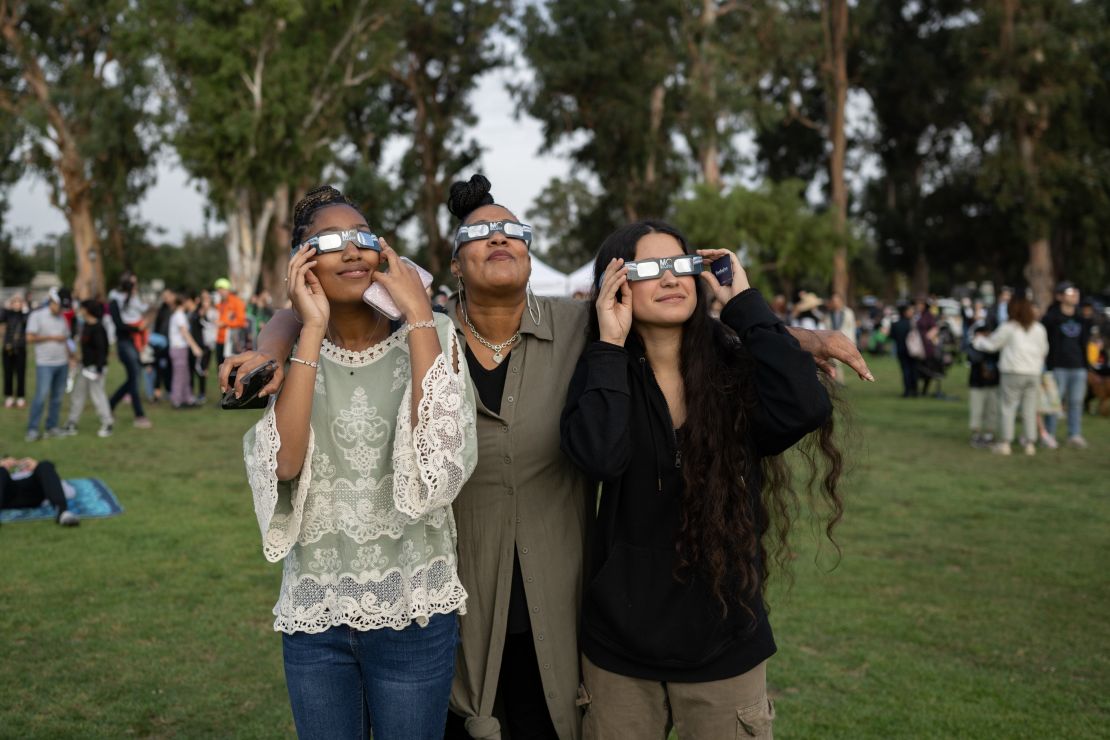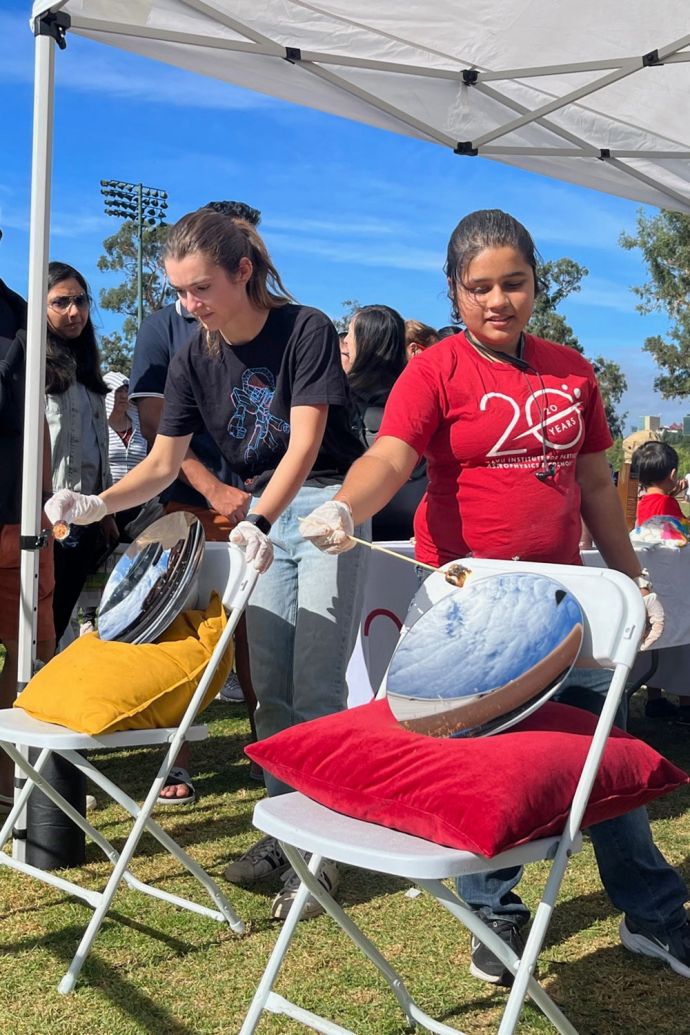Science lovers from across the Bay Area converged on Stanford Saturday morning to observe a partial solar eclipse at a viewing party hosted by the Kavli Institute for Particle Astrophysics and Cosmology, or KIPAC. Hans Larsen attended from nearby Los Altos with his family to enjoy the rare celestial sighting.
“Eclipses don’t happen very often, so this was a good opportunity for the kids to see one for the first time in their lives,” Larsen said.
The free, public, and family-friendly event took place from 8:30 a.m. to 11:30 a.m. on the south intramural fields. An estimated 3,300 attendees gathered with special solar-viewing glasses that protect against solar radiation. Overcast conditions initially limited the view, but the sky cleared intermittently throughout the morning, providing stunning sights of the moon partially blocking the sun.
Shea Hess-Webber is a solar physics research scientist in the Hansen Experimental Physics Lab (HEPL), a KIPAC member, and a representative from NASA’s COFFIES Science Center, which co-organized Saturday’s event. She explained that residents in some parts of the western United States, Mexico, and South America could observe the full annular eclipse, which occurs when the moon passes directly in front of the sun, creating an annulus, or ring, of sunlight around it.
“Only in the line of annularity do you actually see the coverage with the ring. But here, we are getting about 80% coverage,” Hess-Webber said.

Thousands gathered on the south intramural fields to watch and celebrate Saturday’s partial solar eclipse. (Image credit: Carlo Cantavalli)
Stanford solar-bration
Eclipses occur about two to five times a year across the Earth and typically last a few hours from start to finish (full annularity or totality may occur in minutes). Observing the sun without a visual filter can be extremely damaging to the human eye, so in addition to special glasses, attendees viewed the eclipse through sunspotters, solar binoculars, white-light solar telescopes, and H-alpha solar telescopes operated by trained scientists.

A variety of protective viewing tools were available for observing, including glasses and solar binoculars. (Image credit: Carlo Cantavalli)
Throughout the morning, attendees made their way to several activity booths to learn about the eclipse, solar physics, optics, and the solar system. At one booth, visitors played with ultraviolet-sensitive beads that changed colors.
“When you hide them from ultraviolet light, they’re white, and when you expose them to ultraviolet light, they turn colors, … which means you can experiment with them in different environments and scenarios,” Hess-Webber said.
At the popular Solar S’mores booth, Stanford scientists used curved parabolic mirrors to roast marshmallows. Philip Mansfield, a postdoctoral scholar who researches astronomy and astrophysics, helped lead the demonstration.
“All the light that goes in that mirror gets focused on a single point, which means that it can get very, very hot and you can create a fire on the s’more, and you can roast it just like you would over a campfire,” Mansfield said.
Stanford’s researchers were joined by scientists from NASA and the University of California, Berkeley. Saturday’s event was also supported by Lockheed Martin and the San Jose Astronomical Association, which provided six telescopes.
“Most of the volunteers here today are from Stanford, but we also have a lot of support from many external partners who helped make this event possible and fun for the community,” said Xinnan Du, the KIPAC outreach and engagement manager and lead organizer of Saturday’s gathering.

KIPAC staff at the Solar S’mores booth roast marshmallows with parabolic mirrors at the Solar Eclipse Viewing Party on Saturday, Oct. 14, 2023. (Image credit: Alex Kekauoha)
20 years of science
This year, KIPAC is celebrating its 20th anniversary. Founded in 2003, it is one of 15 independent research labs, centers, and institutes at Stanford that is operated by the Office of the Vice Provost and Dean of Research. It is a community of more than 150 scientists who explore new fronts and challenges in astrophysics and cosmology through theory, computation, experiments, and observations. KIPAC is dedicated to science education, organizing science-related events for the community throughout the year.
Saturday’s annular eclipse was the start of the Heliophysics Big Year, a global celebration of solar science and the Sun’s influence on Earth and the solar system. KIPAC’s upcoming events include the public astronomy lecture on solar astrophysics later this month, which will be delivered by Stanford postdoctoral scholar Dr. Sushant Mahajan, and a public stargazing event at the Stanford Student Observatory in December.
Further information about upcoming KIPAC events is available online or by subscribing to the KIPAC mailing list.